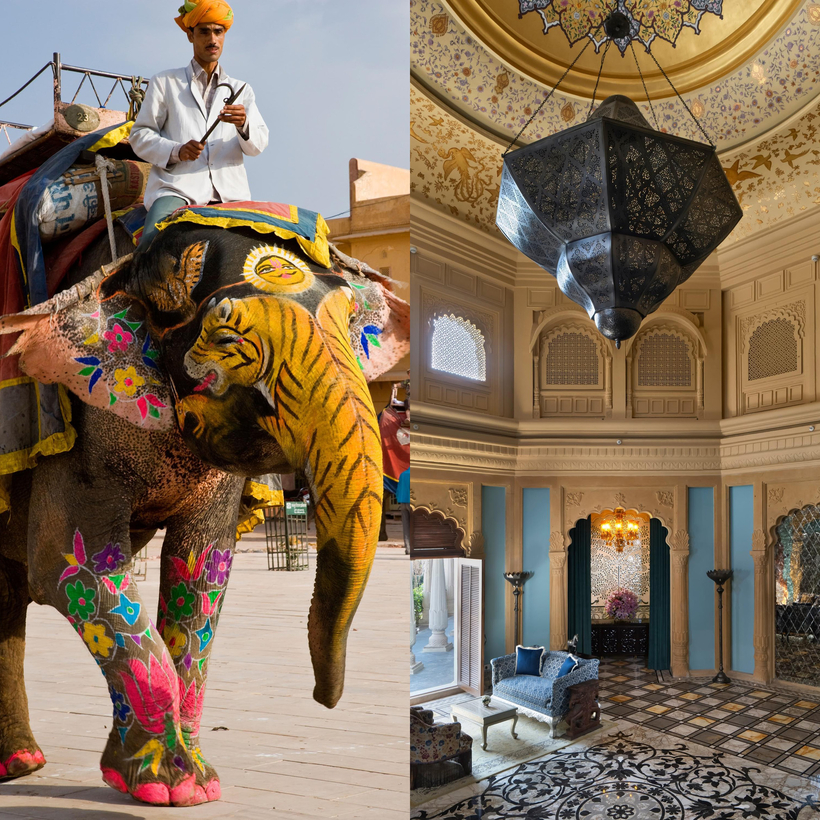There’s no way to get to India from the United States without some discomfort. The 15-hour flight and nine-and-a-half-hour time difference had me in a fugue state when I arrived in Delhi. But in this benighted political year, I was nevertheless optimistic that my destination, Jaipur, would soothe my existential blues, at least for a time.

Though I am no yogi, my last assignment in India was touring yoga retreats in the north. In all my travels there, I had yet to experience Rajasthan and its fairy-tale capital. This trip was crafted to precision by the pros at Scott Dunn, the gold standard in bespoke travel. After a day of recovery, I met up with my driver, Bharwan Singh. We took the new, eight-lane Delhi-Mumbai Expressway five hours south to Jaipur.
Ladies in gilt-edged saris balanced on motorbikes, and vendors sold the season’s first mangoes and bundles of fresh fenugreek. Bharwan weaved around a procession of majestic elephants adorned with garish neon paint lumbering back from Amber Palace, where they give rides to tourists. The saffron-colored fortress elongates above the city that is otherwise resolutely pink, ever since Maharaja Ram Singh II transformed Jaipur with a coat of blush paint to welcome Albert Edward, Prince of Wales, in 1876.

Jaipur has long lured stylish travelers with its cultural sophistication and landmarks such as the Hawa Mahal, or “Palace of the Winds,” whose honeycomb façade is among India’s best-known images. The founder of Jaipur, Maharaja Sawai Jai Singh II, constructed a monumental astrological observatory, Jantar Mantar, as well as an elaborate water-catchment system in the hillside at Nahargarh Fort. Beyond those innovations, he created a series of 36 artisan syndicates, establishing Jaipur’s primacy in gem cutting and the fabrication of fine jewelry, textiles, and carpets.

That legacy endures today; the shopping in Jaipur is head-spinning. Baubles, block-print cotton blouses, and custom linen blazers are just the beginning.
Its cultural offerings are also a draw. A literature festival takes place there each February, and the Jaipur Centre for Art opened last year, showcasing works of Indian and international contemporary masters. And although his title is symbolic in Prime Minister Narendra Modi’s India, 26-year-old Maharaja Padmanabh “Pacho” Singh is the handsome bearer of Jaipur’s royal bloodline. He is also an accomplished polo player and hosts tournaments at the Rajasthan Polo Club, which have included 2025’s first Sirmour Cup. It is sponsored by Raffles, the city’s newest luxury hotel, a descendent of the Singapore original and my home while in Jaipur. (Lucky me.)

Exploring Raffles felt akin to having the keys to someone’s spectacularly furnished home, one with an opulent but intimate entrance foyer rather than a cavernous lobby. Wonders proliferated around every carved-sandstone corner and through many secret doors. A butler, Snehal, personalized my stay, and I quickly understood that the neroli-and-orange-blossom-scented air I was breathing was as rare and restorative as it gets.

According to Binny Sebastian, the hotel’s general manager, this single-point-of-contact system is a hallmark of the Raffles experience worldwide. “Ironing, housekeeping, holding a chair by the pool, or just giving you quiet space if that’s what you request, the butler alone takes care of everything” (without fuss or confusion, because communications primarily transpire over WhatsApp).
Upon my arrival, Snehal offered to draw an herb bath in my suite’s outdoor tub. I declined and instead tipped a flute of Noí, an Indian sparkling rosé. During my stay, Snehal booked a hammam treatment at the spa and delivered on my craving for house-made laddu date balls with a pot of masala chai.

Designed by Bangkok-based architect Clive Gray, Raffles was conceived as a zenana—a separate palace for women—and a delicate counterpoint to the king-size Fairmont next door, which shares an owner, Ratan Kant Sharma. From the sun-warmed Raffles rooftop, I watched (and heard) the spectacle of an Indian wedding at the neighboring property, and then turned my attention back to the infinity pool, rattan lounge chair, and minty limeade.

There was balm in the wind as the sun hung low over bougainvillea, farmland, and, beyond that, the Aravalli hills. Peacocks unleashed piercing whistles.
Every inch of Raffles was crafted or sourced by Rajasthani artisans, infusing it with contour and color. Bright floral paintings line the walls. Regal glass chandeliers hang from hand-carved wood ceilings. Floors fashioned from local marble display multicolored inlay patterns. Elsewhere are mirrored mosaics called thikri and paradigmatic examples of Indo-Islamic architecture such as jalee lattice windows, designed so that women may peer out but will not be seen from the exterior.
The structure’s centerpiece is a three-story atrium anchored by palm trees. It’s grand but also relaxed enough to feel comfortable taking high tea in casual sightseeing clothing.

The restaurant Arkaa, on the ground floor, was perhaps my greatest pleasure. I arrived hungry after visiting the City Palace, the vegetable market, and the forts and temples, and taking an early-morning leopard safari. (Yes, Jaipur has everything.) I perused the gem shops and a fabric store called Indigo, where tailors stitched me a blouse out of block-printed muslin and delivered it to Raffles a few hours—and $37—later.

Over the course of several meals, I dived into pots of chicken tikka, scooped out spicy lamb curry and mint chutney with a tear of garlic naan, and drank buttermilk seasoned with cumin. Chef Lalit Sharma prepared a Rajasthani classic, dal baati churma, a heavenly combination of lentils, wheat rolls, and grains sweetened with jaggery. Bite by bite, I ate my way back into sanity and maybe even perspective—without a single downward dog.
The writer was a guest of Raffles Jaipur, where room rates begin at $475 per night. Her itinerary and tours were organized by Scott Dunn Travel
Marcia DeSanctis is a contributing writer at Travel + Leisure and writes essays and stories for Vogue, Town & Country, Departures, and BBC Travel. Her collection of travel essays is called A Hard Place to Leave: Stories from a Restless Life


